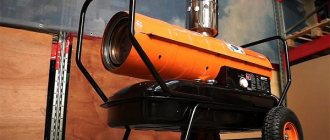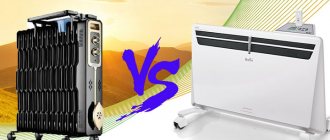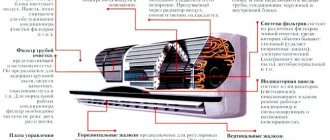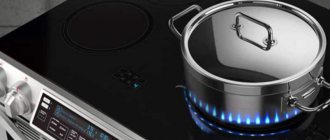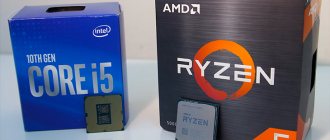Electric convectors that are directly connected to the electrical network via an outlet.
Belarusian-made products - TEPLOPITBEL for heating houses, cottages, apartments, administrative and industrial premises. For preferential heating.
An electric boiler that heats the coolant and sends it to the radiator network.
The choice between these options raises many questions and a whole storm of emotions. Some people ask whether it is better to use a boiler with radiators or electric convectors, others directly argue that only idiots can purchase an electric boiler when it will be enough to hang electrical panels, because pipes are many times more expensive than wires, they give various other arguments on this topic, but all these arguments are unfounded. Let's try to figure it out in this article.
Design and principle of operation of an electric convector
The main components of the device are:
- hollow flat rectangular body, open at top and bottom;
- a heating coil or heating element placed inside it;
- power cable.
Models with a thermostat are available: they are capable of maintaining the room temperature at a user-specified level.
The heating coil is made of nichrome or another alloy with high electrical resistance. The level of heat release during current flow depends on this indicator: Q = I² * R, where
I - current strength;
R is electrical resistance.
According to this law, when connected to a voltage source, the coil heats up. Its temperature rises until the heat removal is equal to its release. If this does not happen, the built-in thermal fuse will open the circuit.
A heating element (tubular electric heater) is an incandescent filament placed in a metal or ceramic housing filled with sand. Its surface temperature is lower than that of an open spiral.
The heating element imparts heat to the air and it rises through an opening in the housing. This phenomenon is called convection. The density of the heated medium decreases and it moves upward. The convective flow draws cold masses through the lower opening in the housing. This is how circulation occurs.
When to use an electric boiler and when to use convectors
Clear boundaries have been established for 4 and 6. What does this mean? If there are 4 heating devices, this is a very small house, then there is no point in starting with an electric boiler and a radiator hydraulic network; it is easier and simpler to get by with electric convectors. If 5 appliances is the limit of thought, you can already purchase an electric boiler or still look towards convectors, and if there are 6 heating appliances, then starting from this number, an electric boiler is definitely recommended.
Where did this division of 4-6 devices come from and where did the practice of using electric boilers in heating systems come from? It’s all simply about economic efficiency. Only when there are few devices, this economic efficiency is hardly noticeable, and when there are many, it becomes significant, but it does not lie on the surface, it needs to be explained, this economic efficiency. Those gentlemen who are making noise about the fact that an electric boiler is never needed anywhere have not yet explained this efficiency to them.
Belarusian plant Teplopitbel - energy-saving heaters, convectors and electric batteries for discounted heating of the house.
Advantages and disadvantages of electric boilers
Despite the fact that the cost of electricity is constantly increasing, electric boilers have not lost their popularity.
A heating device whose operating principle is to convert electrical energy into heat.
Electric boiler
Main advantages of electric boilers:
- low price;
- there are no costs for payment and delivery of fuel (firewood, diesel fuel, etc.);
- ease of use;
- environmental Safety;
- high efficiency;
- noiselessness;
- compact, which allows them to be placed inside the house.
For a type of heater such as an electric boiler, it is important that the mains voltage is stable and reliable. If a malfunction occurs, heating will stop in the entire room.
Disadvantages of heating with an electric boiler:
- high power consumption, so electric heating boilers are suitable only for small houses;
- high cost of electricity.
Electric boilers come in heating element, electrode and induction types.
This is interesting: How to choose a blender for your home in 2021: tips and recommendations from experts
About efficiency
The main postulate is that a central electric boiler is more efficient than individual convectors, despite the fact that it is expensive and electrical panels are cheap.
The electric convector is a high-resistance spiral with high resistance, wound onto a ceramic base and placed in a metal case.
The efficiency of both the boiler and the convectors is the same 98-99%. Where this economic efficiency comes from is not entirely clear.
To clarify, we will use one well-known formula:
A decrease in indoor air temperature by one degree leads to energy savings of 6%
The formula is quite mechanical, plus it does not take into account the outside temperature, but nevertheless it can be used.
What does this formula mean? If we overheated the air in a room by 2 degrees, then we lost 12% of the energy carrier.
What is the economic efficiency of an electric boiler compared to convectors? When we select our heating devices, we calculate their power for the coldest time of the year and add 10-15% to this power, just in case. This is common practice. The boiler is selected with a small margin. With convectors it is a little more complicated, because they are not selected for all the heat loss of the house, but separately according to the heat loss of each room in which these electrical panels will be installed, and plus another small nuisance is that the power step of the convectors is quite large. It is not possible to take a convector with a power of 1070 watts or 1125 watts, we can take a kilowatt, two hundred kilowatts, one and a half kilowatts, two kilowatts and so on.
Energy-saving convector Teplopitbel-Belarusian plant.
When we choose convectors, compared to a boiler for the same house, they will have a power of more than a boiler of 2-4 kilowatts, if we take a house of 200 square meters as an example.
Heating with electric convectors
The design of an electric convector is not much more complicated than that of an electric boiler.
Electric boiler or convectors – the choice is complicated by many factors. We have already talked about the features of water heating with electric boilers, now it’s time to talk about heating with electric convectors. These devices are fairly simple heating devices that operate on the principle of natural convection. They consist of the following parts:
- Air heating elements – provide air heating;
- Control systems – provide temperature control and perform other useful functions (for example, work according to a given program or in the “anti-freeze” mode);
- Housing with slots for intake of cold air and release of hot air.
Thus, this is extremely simple but functional equipment .
Some electric convectors also have additional modules. For example, there are samples on sale with built-in air humidifiers.
The operating principle of electric convectors is very simple. When they are turned on, active heating of the air surrounding the heating element begins. When heated, it rises and leaves the device body through the upper slot holes. In its place, cold air masses immediately enter, sucked through the lower cracks. Hot air flows out by gravity - this is how natural convection works.
The air heated by the convector rises to the top and gradually warms up the entire room.
1-2 hours after switching on, electric convectors completely warm up the air in the rooms. The process is long, but after reaching the set temperature, the heat will be maintained for a long time. Heating is monitored by automation, which ensures that the set temperature is maintained. Moreover, automation in electric convectors can be of two types:
- Mechanical - here there is a simple bimetallic element that turns devices on or off. It is not possible to set the exact temperature here;
- Electronic - the heating process is monitored by an electronic sensor, and the temperature can be adjusted with an accuracy of 0.5-1 degrees , which ensures economical operation. Some advanced electric convectors are even equipped with thermometers with a digital display of the current air temperature.
The use of electronic control allows achieving savings of up to 10% compared to devices with mechanical control.
Let's look at the main advantages of electric convectors. The main advantage is the extremely simple installation of the entire heating system - you just need to hang the equipment under the windows or on blank walls, and then connect it to an electrical outlet. That is, users get rid of the tedious installation of pipes and connecting heating batteries to them. There is also no coolant here.
Installation of the convector is very simple, the most difficult thing is to screw the fastenings to the wall level.
The next advantage is easy, separate temperature control in the rooms. For example, if a certain room is not in use, you can close the door there and turn off the electric convectors installed there. In classic water heating, separate adjustment is also possible, but pipes with hot coolant will still remain here.
Electric convectors are good for their safety. Their back walls practically do not heat up, so the equipment can be mounted close to the walls of the household . The temperature of the front panel does not exceed +90 degrees - an accidental touch will be unpleasant, but will not lead to burns. In addition, electric convectors do not burn oxygen and do not change the chemical composition of the air.
There are certain disadvantages, the first of which is high energy consumption. We have already said that electric heating is expensive, and electric convectors consume about the same as conventional water heating. However, some efficiency here is ensured by the use of precise electronic control and the absence of coolant.
At the initial stage of equipment operation, electricity is almost wasted, since the heating of electric convectors is quite long, and consumption is “to the fullest.”
The next drawback is that if gas appears in a populated area, it will take a fair amount of money to convert the house for water heating with a gas boiler . If there were already pipes and radiators, you would only need to buy a boiler and connect it to the system. In the case of electric convectors, one more problem will have to be solved - where to put the equipment that has become unnecessary.
Also among the disadvantages is the fact that many people do not like the feeling of burnt air, since it does not cool down immediately - its temperature can be high near electric convectors. When using an electric boiler, this effect will not occur.
What happens during work
Minus 28 degrees, the coldest time we have had during the entire heating season. When the temperature is lower, we can set the power in the boiler, which will cover the heat loss at home, for a given temperature outside, i.e. we will not overload the room. When it’s minus 28 degrees outside, we set the boiler power to 14 kW, when it’s minus 10, we set it to 6 kW, at these kilowatts, the boiler will heat the coolant exactly as much as is required to ensure heat loss in the house.
The regulator on the convector is designed in such a way that it can only regulate the air temperature in a given individual room, but it cannot regulate the power of electric convectors, so when the convector turns on, it produces all its 2 kilowatts, and if our room loses at minus 10 500 watts, then 2 kilowatts overheats the air very quickly. The convector will turn on only when it sees that the air has warmed up enough. This means that it will already be overheated by 2 degrees, these 2 degrees of overheating will lead to the fact that we will lose energy by giving off excess heat to the street.
In addition, the electric boiler can be integrated with a bunker tank. Since we have a hydraulic system, we will charge this buffer tank at a cheap night rate so that the boiler does not turn on at all during the day. There is no way we can store power in an electric convector at night.
Bosch electric boiler
And the third feature, which is allowed when using an electric boiler, but is impossible when using electric convectors - very often people choose combined heating systems, an electric boiler and a wood-burning one, an electric one for convenience, and a wood-burning one in order to heat cheaper. During the day it is heated with wood, at night the electric boiler is turned on at an inexpensive tariff. We cannot integrate electric convectors in any way into the hydraulic system where we have a wood-burning boiler.
Three reasons that lead to the fact that an electric boiler is more attractive for use in a private home than separate electric convectors. In addition, there are technical difficulties that accompany the use of convectors.
There are three such technical difficulties:
- The most unpleasant thing is the increased total power of electric convectors. Since we select convectors not for the heat loss of the entire house, but for the heat loss of each individual room, the result is that we exceed the required power by at least 24 kW, we don’t know where to put them and how to provide them, because we don’t have the allowed power limitless, we are having problems with the introductory machine. When all our convectors turn on at a power that we don’t need, but we can’t adjust it, make it less, plus we have washing machines, a kettle, a TV working, the input machine can knock out. The only way to combat this is to walk around and turn off the heating of certain rooms, but this is not convenient because it is cold there and you need to control it so that they do not freeze completely and on the verge of freezing you will have to come and turn on the heating in this room again. This is a big hassle, somewhere, we will definitely miss something, it is impossible to keep track of everything.
- Electrical network. Anyone who believes that by hanging convectors around the house and plugging them into the nearest outlet you have done everything that is required is deeply mistaken. If you are recording powerful electrical appliances that will work for 5-6 hours, be so kind as to connect a separate cable to each individual convector, because if you have a line on which additional electrical appliances will hang, there will be connections that are in over a long period of time they experience high loads, they can start to heat up and no one can guarantee that everything is done with high quality or that something has not oxidized over time. There is a high probability of wire burnout, resulting in a fire.
- The last difficulty is the inability to control convectors remotely, since we can control an electric boiler via SMS. It is possible to control more precisely, but for this all convectors need to be united into a single network, connected to a device that will receive our remote commands. An electric boiler already has all this. Therefore, the cost of electric convectors is similar to radiators and the electrical network that we will need to connect to each convector. An electric boiler will be comparable in price to a smart home that controls a network of electric convectors. From the point of view of initial costs, convectors only benefit if they are simply plugged into sockets. In all other cases, the price of convectors and a boiler with a hydraulic network is approximately the same. The boiler is a little more expensive, but its imaginary high cost pays off in the first year of operation due to the three features that we described above.
What types of electric convectors are there?
They are all similar to each other. They differ only in the installed heating element, additional monitoring and control units. The only thing that should be noted right away is the use of heating elements. The spiral dries out the air greatly, which reduces the quality of the microclimate in the house. With heating elements this does not happen so intensely.
In convectors, these heating elements can be metal or ceramic. The latter are better. Metal heating elements have the same spiral. It is located inside the tube, without contacting its walls. If this happens, a short circuit will occur, which will lead to failure of the heating element. It will just burn out.
Ceramics is an excellent insulator, so the spiral inside the device is tightly pressed against the inner walls of the tube. The absence of air between the elements increases the heat transfer from the heating element. Its efficiency is higher.
The second element is a block with which the temperature of the air leaving the convector is regulated. There are two options here:
- thermostat;
- control board.
The first is a mechanical regulator, with which it is difficult to set the exact temperature. The second is a “smart” device that simply needs to be programmed to the required temperature parameters. The device will do everything itself. It will not only control the temperature inside the house, but also, if necessary, turn off or turn on the power supply (depending on the time of day, the weather outside). You can even control modern devices from your smartphone.
Advantages of electric convectors:
- low price compared to electric boilers;
- ease of installation;
- connection - via a socket;
- the air heats up quickly.
Minuses:
- high electricity consumption;
- dry the air.
Electric convectors on the market are represented by a wide range of models. They differ in power consumption - from 500 Watts and above (0.5 kW). And since the convector heats the air directly, it is believed that this power is the heating characteristic of the device. Therefore, you need to choose according to this indicator.
There is a formula that determines the power of heating devices. For every 1 m² with a ceiling height of 2.7-3.0 m, 100 watts of thermal energy is required. For example, if the area of a room is 20 m², then to heat it you will need a convector with a capacity of 2.0 kW or two of 1.0 kW each.
But this formula is used only if the convector is the main and only source of heat. If it functions as an additional element of the heating system, then a low-power device is selected.
Convectors of different power
Operating principle of an electric boiler
The device distributes the generated heat throughout the house through a water-filled system of pipes and radiators. It is closed in a ring and is called a heating circuit. The working medium, passing through the boiler heat exchanger, is heated, then moves to radiators located in the rooms and releases the resulting energy there.
The movement of water is ensured by a circulation pump.
An expansion tank is needed to ensure that the coolant does not burst the pipes when heated. In its design, it has an elastic membrane, thanks to which the working medium freely increases in volume.
The operation of the boiler is controlled by automation, which senses the temperature of the coolant or air in the room using sensors.
Different models use the following heating elements:
- Heating elements. They are designed similarly to convector ones.
- Electrodes. Voltage is applied to them and current flows directly through the coolant, which leads to its heating.
- Induction coil. Forms an alternating electromagnetic field that induces eddy currents in the walls of the heat exchanger and the core located inside it. The result is heating of these elements.
Heating element boilers are the most common. Other types have significant disadvantages:
- for electrode devices, the salinity of the coolant must be maintained within strict limits so that it has the required resistance;
- induction units cost 2-3 times more than heating elements.
A 2-circuit boiler also works as an instantaneous water heater. But he is unable to perform both functions at the same time. As hot water enters, the heating system is cut off and no heat is supplied to it.
Principles of constructing a heating system using convectors and electric boilers
When considering options for purchasing climate control equipment for heating and trying to understand which is better, an electric boiler or a convector, it is necessary to operate not only with the dry facts of power consumption or the cost of the work project, but also to understand the difference between these heating systems.
The advantage of both heating systems, whether using a boiler or using a convector, is that installation and installation do not require obtaining permits. The exception is the installation of heating equipment with a power of more than 10 kW.
In addition, such a system can be installed without agreement with the energy supply company, if the total power of all consumers does not exceed the power allocated to a separate household or apartment. When calculating the required power consumption, when selecting convectors it is worth using the rule that for every 10 sq. meters of room area require the installation of devices with a power of at least 1 kW. Thus, the room is 12-14 sq. meters it is necessary to install a convector with a power of 1.5 or 2 kW.
When comparing whether an electric boiler or convectors is more convenient, it is reasonable to pay attention to how the rooms will be heated. Individually installed convectors essentially act as autonomous heating systems with an individual control unit. Therefore, by adjusting the air temperature in each individual room, it is possible to significantly reduce energy consumption. This option is recommended for use when heating a room in which people will live all year round. On the other hand, electric heating with convectors of premises with temporary occupancy will be more expensive, since it will require additional equipment to control the temperature during the period of absence of people.
As for the electric boiler, in order to maintain the required temperature conditions, no additional costs are required for connecting the control unit. But there are many more options to save money during the heating season. First of all, a coolant heating system allows you to equalize the temperature in all rooms. The air warms up evenly and does not dry out. With such a system, the building itself is less susceptible to temperature changes during the heating season, and there is an opportunity to save money. Simply, when installing radiators, it is necessary to use control and shut-off valves, with the help of which the temperature of the coolant in the batteries is regulated.
Having assessed which electric boiler or convector is better when used in an autonomous heating system, it is necessary to take into account the costs of laying communications. If we take into account the power consumption of convectors for a small private house, then it is likely that the stationary electrical wiring simply will not withstand the simultaneous switching on of all devices. Therefore, to connect devices with a total power of 6-8 kW, it is necessary to lay a separate power supply line to each connection point.
To install the boiler, in addition to laying wires, you will need to lay out pipes and install radiators, an expansion tank, take into account the cost of shut-off valves and safety devices.
